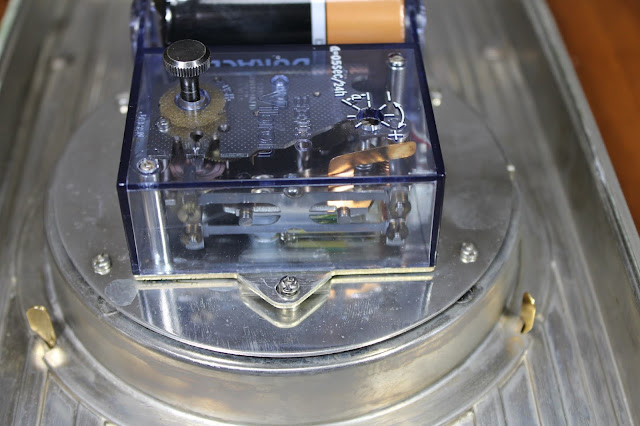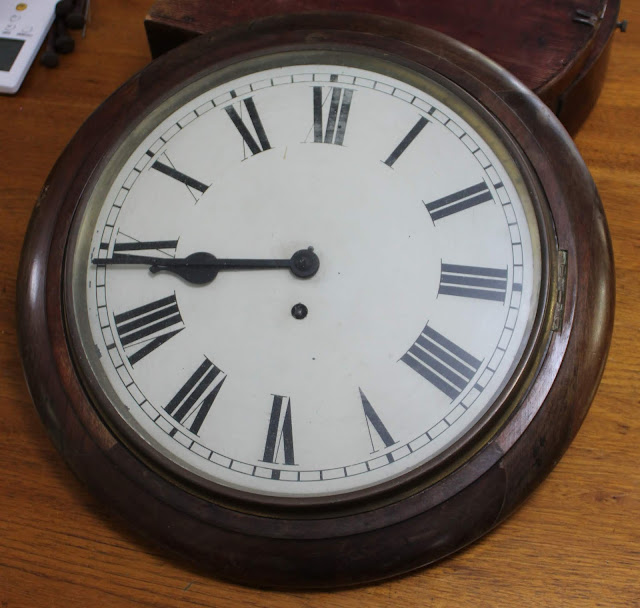Smiths Bakelite Electric Mantle Clock: 50 Hz England
An inexpensive electric syncronous clock made in England for the 240V 50 Hz system, subsequently used in Australia. c1930s through1950s. An electric clock rotates in accordance to its electricity supply frequency that is mainted for high longterm accuracy.
Electric clocks were more accurate and cheaper than mechanical clocks and did not need winding, contributing to the demise of mechanical clocks.
An electric clock loses its time if the supply is cut temporarily. Some electric clocks need to be re-started, so the user is alerted to the time error, but others automatically restart and show the incorrect time.
The frequency of alternating current (AC) electricity grids is kept at a very precise frequency, in part for time keeping. Initially, very accurate master clocks were used to maintain the long-term frequency of a grid. Grid frequency is very important in interconnected grids with multile generators as loads and supply are switched at the zero of the sine wave. Even small deviations, as load or supply come in or out, can trip safety switches. Grids are now syncronised using extremely accurate atomic clocks.
Electric grids run at a specific frequency, 50 Hz and 60 Hz depending on local standards. In Britain and Australia, 240 V, 50 Hz and 110 V 60 Hz in North America.
Almost all clocks were imported to Australia. Electric clocks came from England as the supply frequency is the same. Mechanical clocks were imported from all manufacturers, particulalary American, being low cost and accurate.
From eBay Australia.
https://en.wikipedia.org/wiki/Utility_frequency
https://en.wikipedia.org/wiki/Hammond_Clock_Company
A simple, cheap, but significant clock.
The pressed steel back. An auto restart so a temporary supply interuption is not evident and can show the wrong time.
The small sycronous electric motor inside the case.
Insert photo here??
Significance
Hammond is credited with the invention of the inexpensive electric syncronous clock in the late 1920s and encouraged grid operators to closely regulate frequency using master clocks to allow their use.Electric clocks were more accurate and cheaper than mechanical clocks and did not need winding, contributing to the demise of mechanical clocks.
An electric clock loses its time if the supply is cut temporarily. Some electric clocks need to be re-started, so the user is alerted to the time error, but others automatically restart and show the incorrect time.
The frequency of alternating current (AC) electricity grids is kept at a very precise frequency, in part for time keeping. Initially, very accurate master clocks were used to maintain the long-term frequency of a grid. Grid frequency is very important in interconnected grids with multile generators as loads and supply are switched at the zero of the sine wave. Even small deviations, as load or supply come in or out, can trip safety switches. Grids are now syncronised using extremely accurate atomic clocks.
Electric grids run at a specific frequency, 50 Hz and 60 Hz depending on local standards. In Britain and Australia, 240 V, 50 Hz and 110 V 60 Hz in North America.
Descrition
A simple, inexpensive clock with a case made of the then new plastic, Bakalite. Very accurate and needs no maintainance.Almost all clocks were imported to Australia. Electric clocks came from England as the supply frequency is the same. Mechanical clocks were imported from all manufacturers, particulalary American, being low cost and accurate.
From eBay Australia.
Related clocks
Hammond Clock Co. USA . Available and not expensive on eBay. Acquire one day.https://en.wikipedia.org/wiki/Utility_frequency
https://en.wikipedia.org/wiki/Hammond_Clock_Company
A simple, cheap, but significant clock.
The pressed steel back. An auto restart so a temporary supply interuption is not evident and can show the wrong time.
The small sycronous electric motor inside the case.
Insert photo here??





Comments
Post a Comment